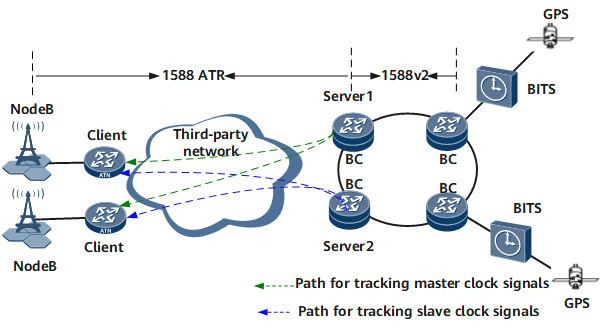Example for Configuring 1588 ATR Transparent Transmission Time Synchronization in a Dual-Server Scenario
In a 1588 ATR domain, a client can establish a client/server relationship with two remote clock servers and send unicast negotiation requests to these clock servers to implement 1588 ATR time synchronization. Once the master clock server becomes faulty, the client automatically initiates a connection request to the slave clock server.
Networking Requirements
On the IP RAN shown in Figure 1, time synchronization needs to be performed between NodeBs, but the third-party network (such as a microwave or switch network) does not support 1588v2. In this case, 1588 ATR can be configured to allow time synchronization over the third-party network. NetEngine 8000 Fs enabled with 1588 ATR can function as a BC to synchronize time information with upstream devices and as a 1588 ATR server to synchronize time information with NodeBs.
Server1 and Server2 are the master and slave clock servers. A client initiates Layer 3 unicast negotiation requests to both Server1 and Server2 using 1588 ATR packets to obtain time synchronization information. If the client is disconnected from Server1, the client then initiates a Layer 3 unicast negotiation request to Server2 to ensure time synchronization with the clock server.
Configuration Roadmap
The configuration roadmap is as follows:
Configure unicast negotiation on a 1588 ATR client.
Configure unicast negotiation on Server1 and Server2.
Adjust parameters of the unicast negotiation between the 1588 ATR client and servers.
Data Preparation
To complete the configuration, you need the following data:
Local server's IP address
1588 ATR domain where the servers reside
Outbound interface for transmitting 1588 ATR packets
DSCP priority value of 1588 ATR packets
Procedure
- Configure unicast negotiation on a 1588 ATR client.
For details about how to configure unicast negotiation on a 1588 ATR client, see the configuration manual.
- Configure unicast negotiation on Server1 and Server2.
- Configure unicast negotiation on Server1.
<Server1> system-view [~Server1] interface loopback 0 [*Server1-Loopback0] ip address 1.1.1.1 32 [*Server1-Loopback0] commit [~Server1-Loopback0] quit [*Server1] ptp-adaptive enable [*Server1] ptp-adaptive device-type server [*Server1] ptp-adaptive time profile [*Server1] ptp-adaptive domain 45 [*Server1] ptp-adaptive local-ip 1.1.1.1 [*Server1] ptp-adaptive atr unicast-negotiate enable [*Server1] interface gigabitethernet 0/1/0 [*Server1-GigabitEthernet0/1/0] ptp-adaptive atr enable [*Server1-GigabitEthernet0/1/0] commit [*Server1-GigabitEthernet0/1/0] quit [*Server1] commit
- Configure unicast negotiation on Server2.
<Server2> system-view [~Server2] interface loopback 0 [*Server2-Loopback0] ip address 2.2.2.2 32 [*Server2-Loopback0] commit [~Server2-Loopback0] quit [*Server2] ptp-adaptive enable [*Server2] ptp-adaptive device-type server [*Server2] ptp-adaptive time profile [*Server2] ptp-adaptive domain 45 [*Server2] ptp-adaptive local-ip 2.2.2.2 [*Server2] ptp-adaptive atr unicast-negotiate enable [*Server2] interface gigabitethernet 0/1/0 [*Server2-GigabitEthernet0/1/0] ptp-adaptive atr enable [*Server2-GigabitEthernet0/1/0] commit [*Server2-GigabitEthernet0/1/0] quit [*Server2] commit
- Adjust parameters of the unicast negotiation between the 1588 ATR client and servers.
- Adjust parameters of the unicast negotiation between the 1588 ATR client and Server1.
[*Server1] ptp-adaptive dscp 60 [*Server1] commit
- Adjust parameters of the unicast negotiation between the 1588 ATR client and Server2.
[*Server2] ptp-adaptive dscp 60 [*Server2] commit
- Verify the configuration.
# View all configurations of the 1588 ATR module on the servers. The following example uses the command output on Server1.
<Server1> display ptp-adaptive all Device config info ------------------------------------------------------------------------------- Ptp adaptive state :enable Device type :server Sync mode :time Current state :master Packet dscp :60 Domain value :45 Local ip :1.1.1.1 Server board :3 Profile :time VPN :none Client info ID Ip Address Clock ID Mode Announce Sync Delay_resp ------------------------------------------------------------------------------- 0 0 3.3.3.3 2cab00fffec65e58 two-way 1 -7 -7 1 1 4.4.4.4 286ed4fffebcdc76 two-way 1 -7 -7# View 1588 ATR related configurations on the servers. The following example uses the command output on Server1.
<Server1> display ptp-adaptive config Device config info ------------------------------------------------------------------------------- Ptp adaptive state :enable Device type :server Sync mode :time Current state :master Packet dscp :60 Domain value :45 Local ip :1.1.1.1 Server board : 3 Profile :time VPN :none Port config info Name ATR enable ----------------------------------- GigabitEthernet0/1/0 true
# View configurations of the 1588 ATR client.
<Server1> display ptp-adaptive client 0 Client id :0 IP address :3.3.3.3 Clock id :2cab00fffec65e58 Mode :two-way Announce interval :1 Announce duration :300s Sync interval :-7 Sync duration :300s Delay_resp interval :-7 Delay_resp duration :300s Receive packet statistics --------------------------------------------------------------------------- Signalling :60 Delay_req :655778 Send packet statistics --------------------------------------------------------------------------- Signalling :60 Announce :2547 Sync :655945 Delay_resp :655778 Discard packet statistics --------------------------------------------------------------------------- Signalling :0 Delay_req :0
Configuration Files
Server1 configuration file
# sysname Server1 # ptp-adaptive enable ptp-adaptive device-type server ptp-adaptive time profile ptp-adaptive domain 45 ptp-adaptive local-ip 1.1.1.1 ptp-adaptive atr unicast-negotiate enable ptp-adaptive dscp 60 # interface Loopback0 ip address 1.1.1.1 255.255.255.255 # interface gigabitethernet 0/1/0 ptp-adaptive atr enable # returnServer2 configuration file
# sysname Server2 # ptp-adaptive enable ptp-adaptive device-type server ptp-adaptive time profile ptp-adaptive domain 45 ptp-adaptive local-ip 2.2.2.2 ptp-adaptive atr unicast-negotiate enable ptp-adaptive dscp 60 # interface Loopback0 ip address 2.2.2.2 255.255.255.255 # interface gigabitethernet 0/1/0 ptp-adaptive atr enable # return
